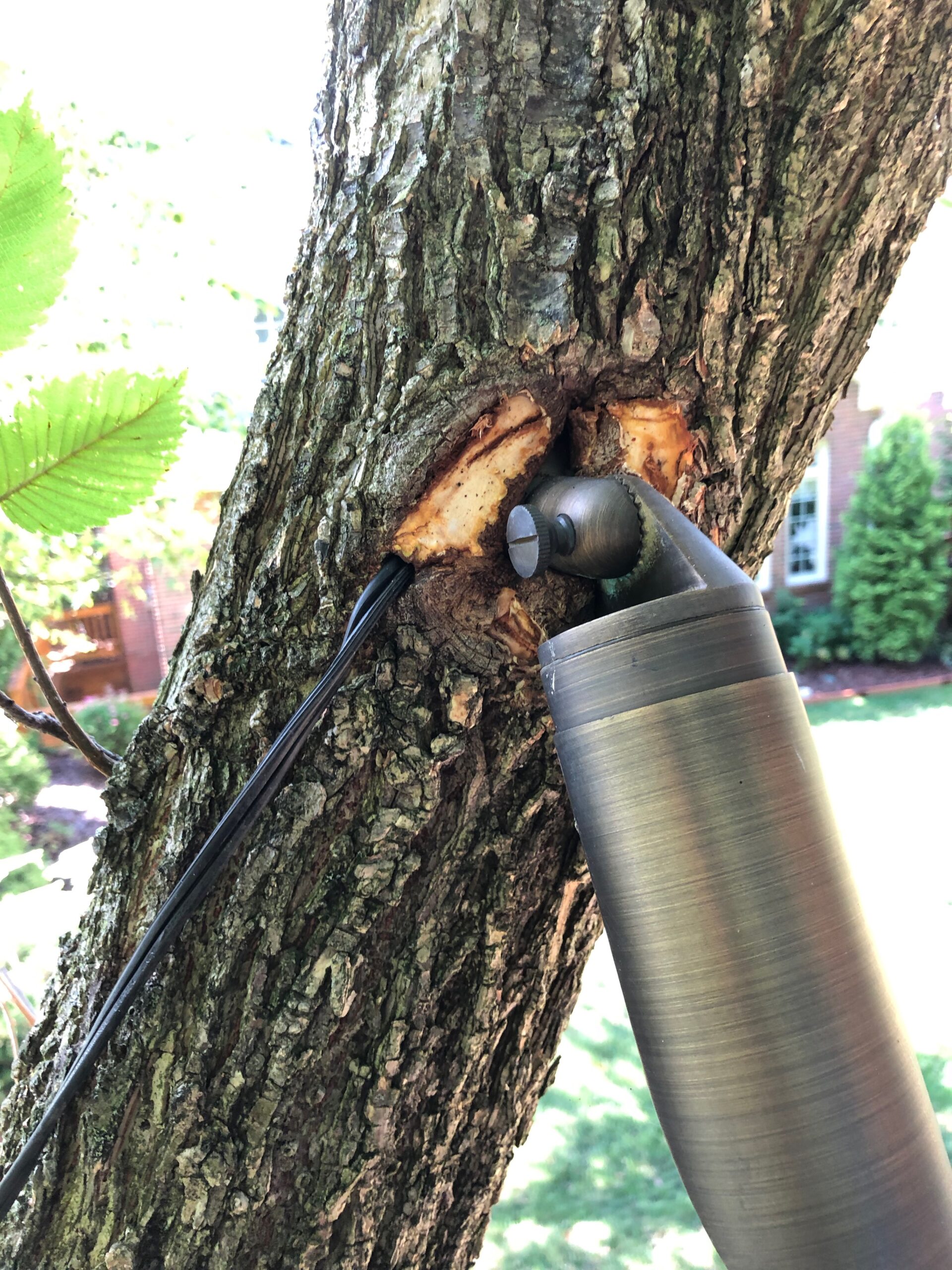Moonlighting is an effect that is achieved by placing lights high in the canopies of trees and pointing them to the ground through branches and leaves to create a dappled, moonlight effect on the ground below. This is a very beautiful lighting technique, but one that requires a degree of preventative maintenance to protect the integrity of the lighting equipment and the tree on which it sits.
This guide covers a quick list of such preventative maintenance techniques to ensure your tree-mounted lights remain as dazzling as the day you switched them on. Keep reading for some tips and frequently asked questions.
Why Tree Mounted Light Maintenance Is Necessary
Trees actively grow at different rates through a season, and some will add girth to the trunk and branches faster than others, depending on the particular species and local growing conditions.
Wires and fixtures mounted to these living specimens will require some adjustments. This usually needs to happen seasonally to mitigate the process of growth expansion and the possibility of the tree overgrowing and swallowing the equipment.
Plus, most landscape features in outdoor spaces are prone to weather and environmental damage. Long-term exposure to the elements and curious critters means wear and tear is inevitable, so seasonal maintenance is essential.
Interested in How We Can Help Maintain Your Tree Landscape Lights?
5 Tips for Tree Mounted Lighting Maintenence
It’s clear that tree mounted lighting fixtures need consistent tweaks and adjustments from season to season. Have a look at some of the seasonal adjustments required:
- Back out the screws slightly on the cable ties that hold the power cable going up the tree to allow for another season of growth and to ensure the wire is not strained by the previous season’s tree growth.
- Back out the fixture mounting screws and bolts to allow for another season of growth so that the growing and expanding tree bark doesn’t force and break off the mount from the tree.
- Trimming back new tree limbs and plant growth that has grown out in front of the light and started to block the light output and effects. These new branches will also create “hot spots” in the canopy of the trees due to their proximity to the source and must be eliminated.
- Inspecting for wire damage from squirrels or chipmunks who may have chewed on the wiring.
- Checking and adjusting the aim of the fixtures to ensure they are still performing as they were intended and haven’t been knocked out of alignment.
What Will Happen if You Don’t Maintain Your Tree Lights?
Not maintaining your tree lights can result in a few hazardous and costly situations.
- Tree damage: If you leave the lights tightly wrapped around tree trunks and branches while they grow, it can lead to damage. Not only can it stunt a tree’s growth, but the lights will become less effective over time, which is a waste of your money.
- Electrical shock: Damaged cords, light bulbs, or any exposed wires could cause an electrical shock when plugged in.
- Fire hazard: Old, defective, and worn-out light bulbs are a recipe for disaster as they can overheat and ignite. This is especially risky if you live in a dry environment and leave these damaged lights on overnight or for extended periods.
FAQs About Tree Mounted Landscape Lights
Have a look at some of these commonly asked questions about tree mounted lights.
1. What Is the Best Lighting for Trees?
This depends on the shape and size of the tree, as well as the desired effect. However, warm white light, between 2,700k and 3,000k, is generally a good choice for most trees. Keep in mind that warmer lights illuminate the tree’s brown, orange, and tan hues, whereas cooler lights, over 4,500k, highlight the greens in the leaves.
2. How Are Tree Lights Typically Wired?
Landscape tree lights are typically wired by using either the daisy chain method or the loop method. Use the daisy chain method for above-ground installations, shorter runs, and hard-to-reach areas. A loop chain wiring helps reduce voltage drop while maintaining uniform brightness for outdoor light fixtures.
3. What Is the Best Way To Install Tree Landscape Lighting?
Avoiding damage to the tree should be your main objective when installing landscape lighting. Firstly, you’d want to use tree straps that can wrap around the tree and grow with it. Avoid wrapping the tree with hard plastic or metal ties. Instead, use plastic hooks and stainless steel screws with zip ties, allowing enough room for the tree to grow.
4. Can You Leave Outdoor Lights Plugged in When It Rains?
Yes. It’s generally safe to leave outdoor lights plugged in during rain as long as they’ve been properly installed and are specifically designed for outdoor use.
5. What Kind of Lights Are Best for Tree Lighting?
LED lights are generally considered the best for tree lighting. They are energy efficient, have long lifespans, and can be customized in terms of brightness and color temperatures.
6. What Are the Different Types of Outdoor Tree Lighting?
The most common type of tree lighting includes tree moonlighting, uplighting, and downlighting. Moonlighting is a special type of downlighting designed to mimic moonlight by placing a light fixture high up in the trees, angled downwards.
Uplighting is when you place a light fixture under the tree, pointing upwards, creating a soft and natural illusion. Then, for downlighting, the light source is placed above the tree, pointing downwards to create a dramatic mood.
Too Busy? Let Us Maintain Your Tree Mounted Lighting
This is only a small segment of the Lighthouse 7-point preventative maintenance service program that we perform for our clients to keep their lighting systems and landscape design looking and working like new.
Do you have a lighting system in need of maintenance? Lighthouse Outdoor Lights also services and repairs the systems other companies have abandoned.
Get Started: Call us today to schedule a system evaluation and preventative maintenance tune-up.

